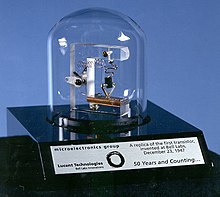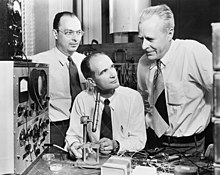For other uses, see Transistor (disambiguation).
A transistor is a semiconductor device used to amplify and switch electronic signals and electrical power. It is composed of semiconductor material with at least three terminals for connection to an external circuit. A voltage or current applied to one pair of the transistor's terminals changes the current through another pair of terminals. Because the controlled (output) power can be higher than the controlling (input) power, a transistor can amplify a signal. Today, some transistors are packaged individually, but many more are found embedded in integrated circuits.
The transistor is the fundamental building block of modern electronic devices, and is ubiquitous in modern electronic systems. Following its development in the early 1950s, the transistor revolutionized the field of electronics, and paved the way for smaller and cheaper radios, calculators, and computers, among other things.
Contents[hide] |
[edit]History
Main article: History of the transistor
The thermionic triode, a vacuum tube invented in 1907, propelled the electronics age forward, enabling amplified radio technology and long-distancetelephony. The triode, however, was a fragile device that consumed a lot of power. Physicist Julius Edgar Lilienfeld filed a patent for a field-effect transistor (FET) in Canada in 1925, which was intended to be a solid-state replacement for the triode.[1][2] Lilienfeld also filed identical patents in the United States in 1926[3] and 1928.[4][5] However, Lilienfeld did not publish any research articles about his devices nor did his patents cite any specific examples of a working prototype. Since the production of high-quality semiconductor materials was still decades away, Lilienfeld's solid-state amplifier ideas would not have found practical use in the 1920s and 1930s, even if such a device had been built.[6] In 1934, German inventor Oskar Heil patented a similar device.[7]
From November 17, 1947 to December 23, 1947, John Bardeen and Walter Brattain at AT&T's Bell Labs in the United States, performed experiments and observed that when two gold point contacts were applied to a crystal of germanium, a signal was produced with the output power greater than the input.[8] Solid State Physics Group leader William Shockley saw the potential in this, and over the next few months worked to greatly expand the knowledge of semiconductors. The term transistor was coined by John R. Pierce as a portmanteau of the term "transfer resistor".[9][10] According to Lillian Hoddeson and Vicki Daitch, authors of a biography of John Bardeen, Shockley had proposed that Bell Labs' first patent for a transistor should be based on the field-effect and that he be named as the inventor. Having unearthed Lilienfeld’s patents that went into obscurity years earlier, lawyers at Bell Labs advised against Shockley's proposal since the idea of a field-effect transistor which used an electric field as a “grid” was not new. Instead, what Bardeen, Brattain, and Shockley invented in 1947 was the first bipolar point-contact transistor.[6] In acknowledgement of this accomplishment, Shockley, Bardeen, and Brattain were jointly awarded the 1956 Nobel Prize in Physics "for their researches on semiconductors and their discovery of the transistor effect."[11]
In 1948, the point-contact transistor was independently invented by German physicists Herbert Mataré and Heinrich Welker while working at the Compagnie des Freins et Signaux, a Westinghouse subsidiary located in Paris. Mataré had previous experience in developing crystal rectifiers fromsilicon and germanium in the German radar effort during World War II. Using this knowledge, he began researching the phenomenon of "interference" in 1947. By witnessing currents flowing through point-contacts, similar to what Bardeen and Brattain had accomplished earlier in December 1947, Mataré by June 1948, was able to produce consistent results by using samples of germanium produced by Welker. Realizing that Bell Labs' scientists had already invented the transistor before them, the company rushed to get its "transistron" into production for amplified use in France's telephone network.[12]
The first silicon transistor was produced by Texas Instruments in 1954.[13] This was the work of Gordon Teal, an expert in growing crystals of high purity, who had previously worked at Bell Labs.[14] The first MOS transistor actually built was by Kahng and Atalla at Bell Labs in 1960.[15]
[edit]
http://en.wikipedia.org/wiki/Transistor



Tidak ada komentar:
Posting Komentar